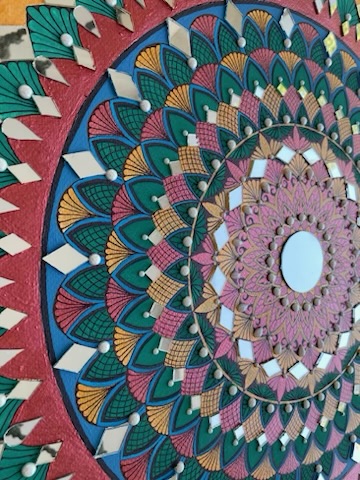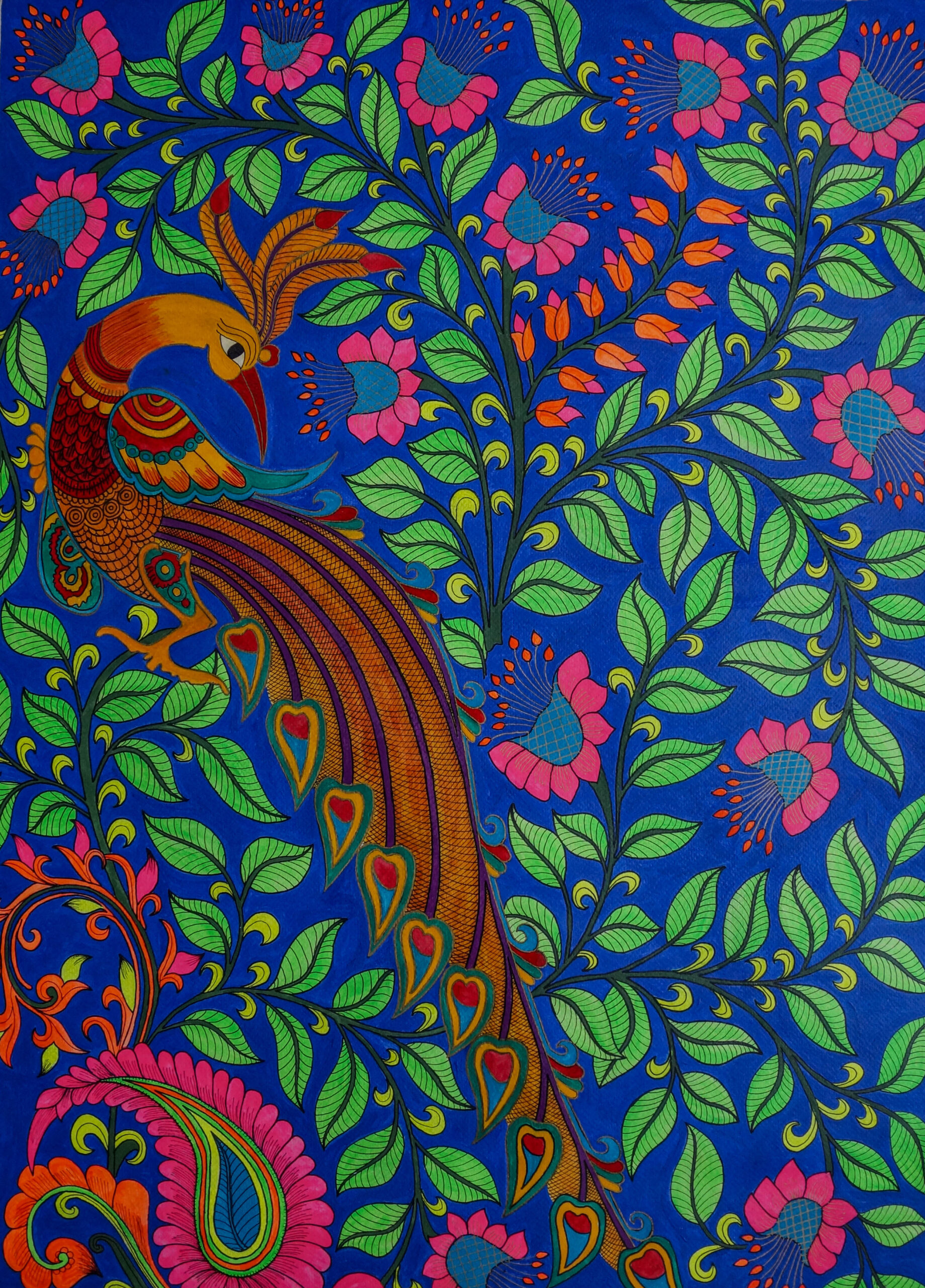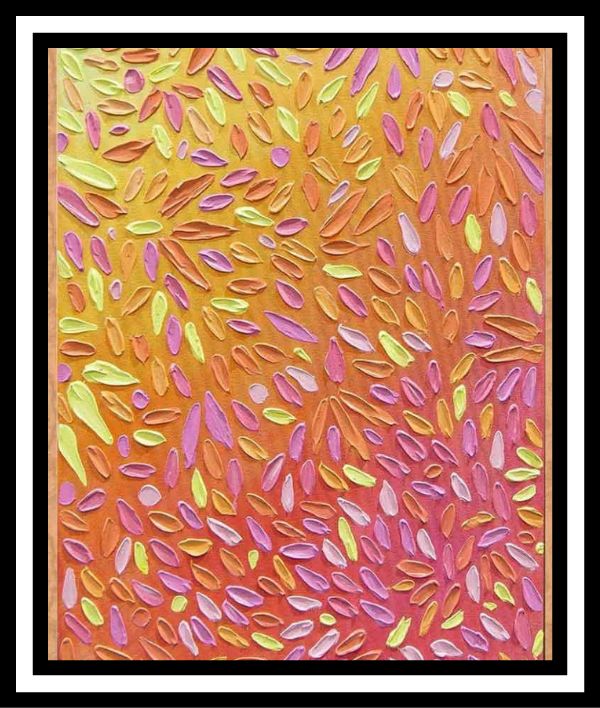Welcome to The
World of Creativity by Pooja Patel
Meet the Artist
Introducing Pooja Patel, a visionary artist whose creativity knows no bounds. With a passion for pushing the boundaries of artistic expression, Pooja seamlessly weaves together a tapestry of diverse art forms, captivating the world with their innovative spirit. Pooja's artistic prowess shines particularly in several forms of art.
“Art is the mirror reflecting the beauty and chaos within me.”

Mandala Art: Unveiling the Symmetry of the Soul
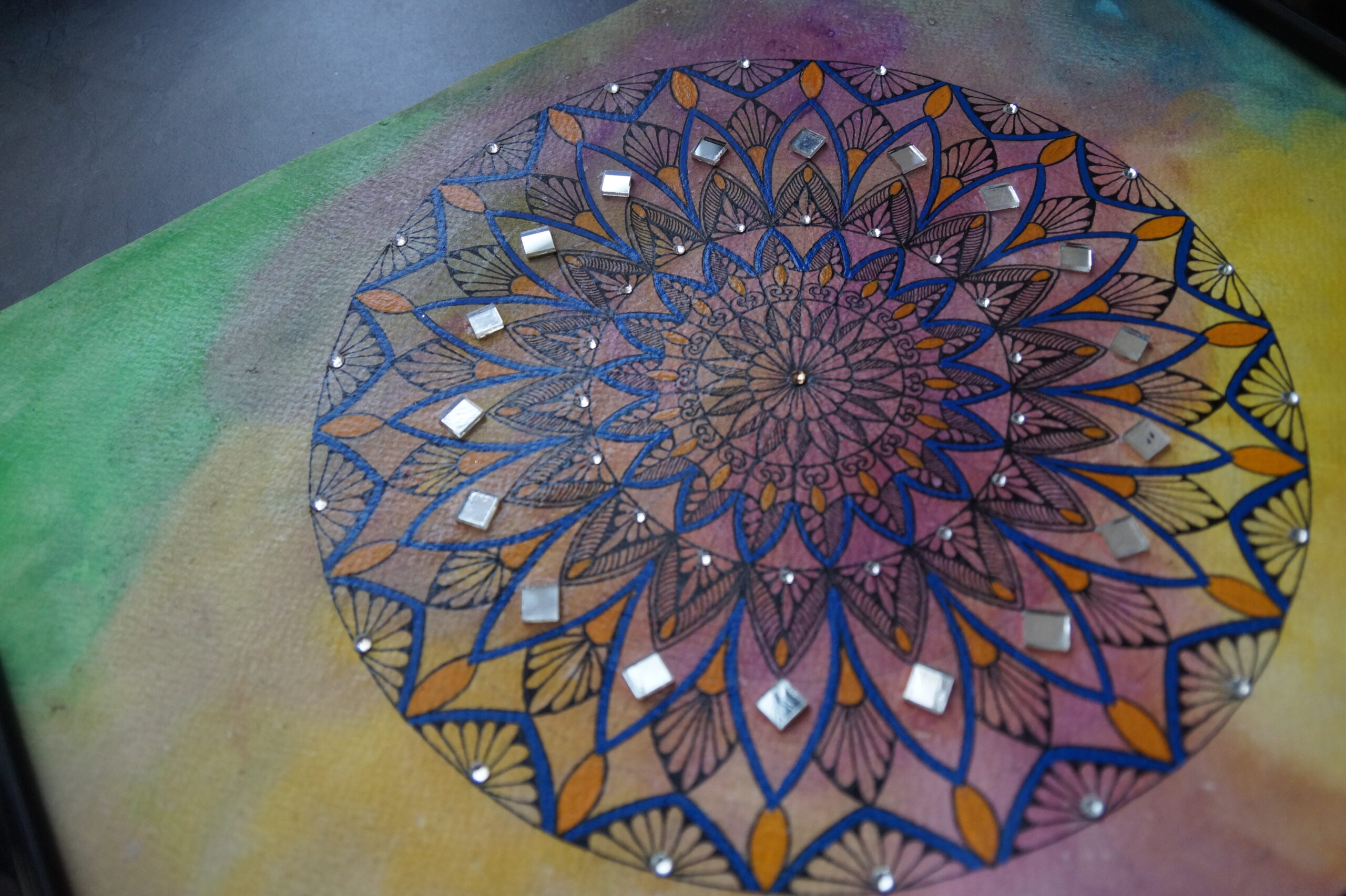
Introduction
Mandala art is a mesmerizing and ancient form of creative expression that has transcended time and culture. Rooted in rich historical traditions and revered for its numerous psychological and spiritual benefits, the mandala is a captivating art form that continues to inspire and intrigue individuals across the world.
Historical Roots
The word “mandala” derives from the ancient Indian language of Sanskrit and translates to “circle.” Mandala art has a history that spans millennia, with origins in various cultures and religions. In its most basic form, the mandala is a geometric design comprising a central point surrounded by symmetrical patterns radiating outward. It has been used in Hinduism, Buddhism, and Tibetan culture for spiritual and meditative purposes, symbolizing the universe, the self, and the interconnectedness of all things.
Cultural Significance
In Tibetan Buddhism, sand mandalas are created by monks in an intricate and painstaking process, only to be ritualistically dismantled upon completion, illustrating the impermanence of all things. In Hinduism, mandalas are used as spiritual symbols, with the center representing the divine and the radiating patterns symbolizing the expansion of consciousness.
Meditation and Relaxation
One of the most profound benefits of mandala art is its therapeutic qualities. Engaging in the creation of a mandala can be a meditative and calming experience. Focusing on intricate patterns and symmetrical designs helps individuals achieve a sense of inner peace, reduce stress, and attain a state of mindfulness. The repetitive, rhythmic motions required for mandala art can have a soothing effect on the mind, making it an ideal tool for relaxation.
Self-Expression and Creativity:
Mandala art offers an outlet for personal creativity and self-expression. As individuals design their own mandalas, they can incorporate personal symbolism, colors, and patterns, allowing for a deep exploration of their inner selves. This process fosters a sense of self-discovery and self-acceptance, as well as an avenue for artistic expression that is accessible to all, regardless of prior artistic experience.
Healing and Therapeutic Applications
Mandala art therapy has been widely used in clinical settings to aid individuals in processing emotions, trauma, and mental health challenges. Therapists often employ mandala-making as a tool to encourage self-awareness and as a means of promoting emotional healing. The act of creating a mandala can help individuals connect with their subconscious, confront unresolved issues, and facilitate a journey toward emotional well-being.
Unity and Wholeness
The very essence of the mandala is its interconnectedness and balance. Creating and contemplating mandalas can help individuals perceive the unity and harmony in life and the world around them. This art form can remind us of the balance needed in our own lives and encourage a holistic perspective that embraces both the chaotic and the tranquil.
In conclusion, mandala art is a profound and ancient form of expression that continues to captivate people worldwide. Its historical significance, therapeutic benefits, and power to inspire creativity make it a valuable tool for self-discovery, relaxation, and spiritual exploration. Whether used as a form of artistic expression, meditation, or therapy, the mandala remains a symbol of harmony and unity, inviting individuals to connect with their inner selves and the broader universe.
Mandala Art's Gallery
Kalamkari Art: A Tale of Ancient Elegance and Timeless Craftsmanship
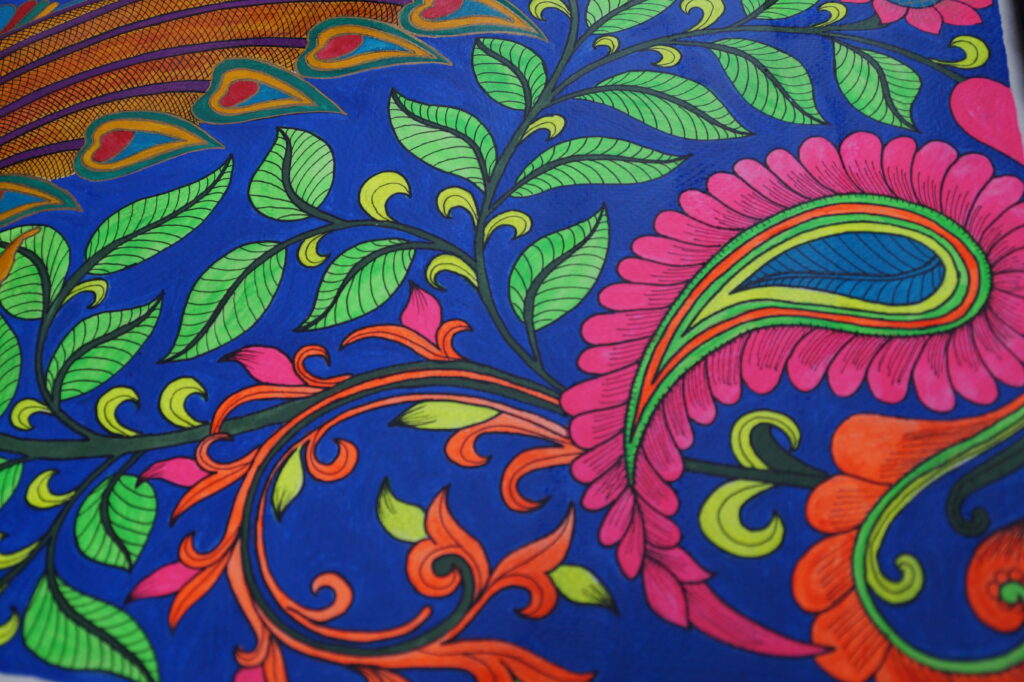
Introduction
Kalamkari art, a magnificent traditional form of textile art hailing from India, is a captivating tapestry of history, intricate craftsmanship, and vibrant storytelling. This unique art form has stood the test of time, enchanting art enthusiasts and connoisseurs with its exquisite hand-painted designs. Its roots run deep, and its rich cultural heritage continues to inspire and flourish.
Historical Legacy
The term “Kalamkari” finds its origin in two Persian words: ‘kalam’ (pen) and ‘kari’ (work), signifying the art of hand-painted fabric. Its history dates to ancient India, with recorded mentions as far back as 3000 BCE, making it one of the world’s oldest textile art forms. This tradition has two distinct styles – Srikalahasti and Machilipatnam, named after the towns in Andhra Pradesh, where they originated. Each has its unique techniques, motifs, and artistic interpretations.
Process and Craftsmanship
Kalamkari is celebrated for its meticulous and labor-intensive process. Skilled artisans utilize natural dyes, such as indigo, madder, and myrobalan, to create a vast spectrum of colors. Intricate designs are rendered by hand, using a pointed bamboo or metal nib dipped in a dye, to create the fine lines that define Kalamkari. The subject matter often draws from mythology, nature, and folklore, telling vivid and enchanting stories within the fabric.
Benefits and Significance
- Cultural Preservation: Kalamkari art is not just a beautiful textile; it’s a living testament to the cultural traditions and heritage of India. It helps preserve the stories, myths, and legends of the region, passing them on through generations.
- Artistic Expression: For the artisans, Kalamkari is a profound form of artistic expression. It allows them to showcase their skills and creativity, often passed down through families for generations.
- Economic Empowerment: The production of Kalamkari textiles provides employment opportunities to many, especially in rural areas. This craft supports livelihoods and empowers artisans and their communities.
- Sustainable Practices: Kalamkari traditionally uses natural dyes and processes that are eco-friendly, promoting sustainable and responsible artistic practices.
- Cultural Diplomacy: Kalamkari art has transcended borders, earning recognition and admiration worldwide. It serves as a cultural bridge, fostering appreciation and understanding between different nations and cultures.
- Versatile Usage: Kalamkari textiles are used in various forms, from clothing and home decor to artwork and collectibles, showcasing its versatility and adaptability.
Modern Resurgence
In contemporary times, Kalamkari art has seen a resurgence in popularity. Designers and fashion enthusiasts are drawn to its unique aesthetics, and art collectors value Kalamkari pieces as valuable investments. The revival of this timeless art form serves to celebrate the enduring legacy of Kalamkari and its continued relevance in the modern world.
In conclusion, Kalamkari art is a testament to the enduring creativity and cultural richness of India. Its intricate craftsmanship, historical significance, and versatility make it a treasured art form. Whether cherished for its storytelling, craftsmanship, or cultural importance, Kalamkari continues to captivate and inspire those who are fortunate enough to experience its beauty and history.
Kalamkari Art's gallery
Textured Art: The Multisensory Canvas of Creativity

Introduction
Textured art is a captivating and innovative form of artistic expression that goes beyond the traditional flat canvas. It engages the senses on multiple levels, transforming two-dimensional artworks into three-dimensional masterpieces that appeal to both the visual and tactile senses. This dynamic form of art has a fascinating history and offers a range of benefits to both artists and art enthusiasts.
Historical Roots
While textured art as we know it today has gained significant popularity in recent decades, it has its roots in artistic movements that explored texture, such as Impressionism and Abstract Expressionism. Artists like Vincent van Gogh and Jackson Pollock utilized impasto techniques and layered brushstrokes to add texture and depth to their paintings. In more contemporary times, artists have pushed the boundaries of texture by incorporating various materials, including paper, fabric, found objects, and even digital elements.
Benefits of Textured Art
Multisensory Experience: Textured art offers a multisensory experience, engaging not only the visual sense but also the sense of touch. Viewers are encouraged to explore the artwork with their fingertips, deepening their connection to the piece.
Expressive Potential: Texture adds a new dimension to artistic expression. Artists can convey emotions, narratives, and ideas through the physicality of their work, creating layers of meaning that transcend the visual realm.
Visual Depth: Texture creates visual depth and contrast, making artworks more intriguing and dynamic. It can guide the viewer’s eye, evoke different moods, and bring paintings to life.
Tactile Therapy: Creating textured art can be therapeutic for artists, as the tactile process of building up layers and textures can be calming and meditative. It allows for a tangible connection between the artist and the artwork.
Inclusivity: Textured art can be particularly appealing to individuals with visual impairments, as it allows them to experience and appreciate art through touch, making it a more inclusive and accessible form of artistic expression.
Experimentation: Textured art encourages artists to experiment with a wide range of materials, from paint and gels
Contemporary Applications
Textured art has gained prominence in the contemporary art world, with artists using a diverse array of materials and techniques to create tactile masterpieces. These artworks can range from mixed-media collages and sculptures to digital art with haptic feedback. Textured art has found its place in galleries, museums, and even public spaces, enriching the art world with its sensory allure.
In conclusion, textured art is a dynamic and captivating form of artistic expression that offers a multisensory experience and an innovative platform for artists to convey their ideas and emotions. This exciting genre builds upon a rich artistic history, adding depth and texture to the world of visual art and engaging viewers on both tactile and visual levels.
